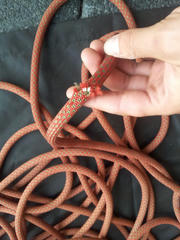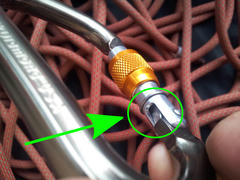I recently had the misfortune of cutting the sheath midway along a brand new rope whilst taking a catching a lead fall while climbing indoors. How might this happen? Climbing gyms are carefully controlled environments. The quickdraws on the wall that get used during lead climbing are likely checked for damage, or excessive wear and replaced on a regular basis. The holds are not sharp, and the climbs are designed in a way which has relatively low rope wear. It’s hard to imagine such a thing happening indoors.
We soon discovered that whilst belaying the falling climber, the belay carabiner flipped over and became cross loaded. This is a situation whereby the load on the carabiner is across its short axis, with either the rope, or the harness pulling directly on the gate of the biner. One thing to note is that carabiners are usually rated to only a fraction of their strength when they are loaded in this way, so this is a situation one should be avoiding. Carabiners used for belaying are normally an asymmetrical shape, where one end is smaller than the other. This helps to prevent cross loading. In my case, the point on the gate between the closing screw and the hinge where it is joined to the body of the biner at the hinge has sharp edges. Evidence in the form of sheath material wedged in the hinge goes to show that for some carabiner designs it is possible for the rope to become wedged and trapped in this position. The lip on the body of the biner helped to stop the rope sliding off the gate as it was loaded during the fall. As the rope traveled over the gate in this position, the sharp edges cut the sheath, leaving material wedged in the hinge. The carabiner brand were very helpful, and replaced the rope, so no hard feelings there, but I have several things to take away from this which I’d like to share:
- Always check your own new equipment for defects. In this case, it seems likely that it was a deficit in the design which I would not have been able to recognise, but it is entirely possible that a new piece of equipment could have obvious dangerous defects, which a quick observation could point out. I tend to place a large amount of trust in the equipment we use while climbing, especially when it is new, but that doesn’t mean we shouldn’t check it before we use it.
- Carabiner designs, while tried and tested, could be improved. A simple bevel on this sharp edge would have greatly reduced its potential to cut a rope.
- Save up and get yourself a special belay carabiner such as the Gridlock from Black Diamond or the Belay Master from DMM. If used correctly, these eliminate the possibility of cross-loading occurring while belaying your partner.


